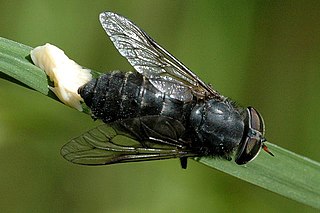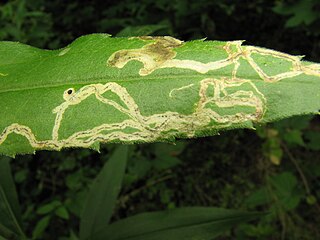Related Research Articles

Flies are insects of the order Diptera, the name being derived from the Greek δι- di- "two", and πτερόν pteron "wing". Insects of this order use only a single pair of wings to fly, the hindwings having evolved into advanced mechanosensory organs known as halteres, which act as high-speed sensors of rotational movement and allow dipterans to perform advanced aerobatics. Diptera is a large order containing an estimated 1,000,000 species including horse-flies, crane flies, hoverflies and others, although only about 125,000 species have been described.

The Phoridae are a family of small, hump-backed flies resembling fruit flies. Phorid flies can often be identified by their escape habit of running rapidly across a surface rather than taking to the wing. This behaviour is a source of one of their alternate names, scuttle fly. Another vernacular name, coffin fly, refers to Conicera tibialis. About 4,000 species are known in 230 genera. The most well-known species is cosmopolitan Megaselia scalaris. At 0.4 mm in length, the world's smallest fly is the phorid Euryplatea nanaknihali.

The fly Megaselia scalaris is a member of the order Diptera and the family Phoridae, and it is widely distributed in warm regions of the world. The family members are commonly known as the "humpbacked fly", the "coffin fly", and the "scuttle fly". The name "scuttle fly" derives from the jerky, short bursts of running, characteristic to the adult fly. The name "coffin fly" is due to their being found in coffins, digging six feet deep in order to reach buried corpses. It is one of the more common species found within the family Phoridae; more than 370 species have been identified within North America.

Hybomitra is a genus of horse flies in the family Tabanidae. There are at least 240 described species in Hybomitra.
Leucotabanus ambiguus is a species of horse flies in the subfamily Tabaninae, in the order Diptera ("flies").
Cyrtopogon lutatius is a species of robber flies in the family Asilidae, in the order Diptera ("flies").
Laphria virginica is a species of robber flies in the genus Laphria, in the order Diptera ("flies").
Liancalus limbatus is a species in the family Dolichopodidae, in the order Diptera ("flies").
Sintoria cyanea is a species of robber flies, insects in the family Asilidae, in the order Diptera ("flies").

Allograpta exotica is a species in the family Syrphidae, in the order Diptera ("flies").
Eucelatoria bryani is a species in the family Tachinidae, in the order Diptera ("flies"). It is found in North America.
Dalmannia nigriceps is a species in the family Conopidae, in the order Diptera ("flies").
Phytomyza opacae is a species in the family Agromyzidae, in the order Diptera ("flies").

Phytomyza is a genus of leaf miner flies in the family Agromyzidae. At least 170 described species are placed in Phytomyza.

Tephritini is a tribe of fruit flies in the family Tephritidae. There are about 12 genera and at least 40 described species in Tephritini.
Aphoebantus conurus is a species of bee flies in the family Bombyliidae.
Aphoebantus is a genus of bee flies. There are at least 80 described species in Aphoebantus.
Metadioctria is a genus of robber flies in the family Asilidae. There are at least three described species in Metadioctria.
Notiphila scalaris is a species of shore flies.

Aphoebantini is a tribe of bee flies in the family Bombyliidae. There are about 5 genera and at least 80 described species in Aphoebantini.
References
- ↑ "Aphoebantus scalaris Species Information". BugGuide.net. Retrieved 21 January 2018.
- ↑ "Aphoebantus scalaris Report". Integrated Taxonomic Information System (ITIS). Retrieved 21 January 2018.
- ↑ "Aphoebantus scalaris Species Overview". Encyclopedia of Life. Retrieved 21 January 2018.